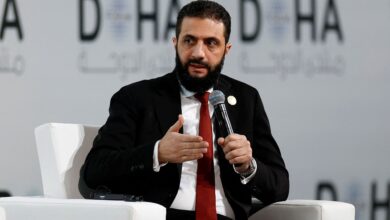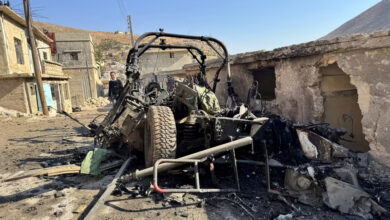Even as the Assad regime pursues Syria’s descent into a sectarian wasteland, its cruelty cannot obscure a discernible shift in the violent stalemate between the regime and the revolution that has endured for the past year. In recent months, the erosion of the Assad regime has acquired new momentum. The regime may have retaken the ruins of Douma, yet its military is unraveling both from below and, increasingly, from above. The defection of Brigadier General Manaf Tlass, once a close friend of Bashar al-Assad, has exposed deepening rifts among the regime’s inner circles. His defection will not be the last.
The armed opposition, on the other hand, is becoming better coordinated and more effective. The Turkish military is massing on the Syrian border. Turkey’s government gives an increasingly free reign to opposition fighters who use its territory as a de facto safe haven. Sanctions have driven Syria’s economy into a freefall. The business communities of Damascus and Aleppo have largely “flipped,” though without the public disavowals of the Assads that the West would prefer.
These trends all point to one conclusion: the end of the Assad regime is drawing nearer. The relevant question is no longer whether the regime will fall, but when and, even more importantly, how. If the exact timing of its demise cannot be predicted, there are nonetheless growing indications that governments opposed to the Assad regime, and even those still supporting it, are increasingly concerned with how to manage the end game in Syria and protect their interests in a post-Assad era.
This new emphasis was evident in the Geneva meetings between the US, Russia, and Joint Special Envoy Kofi Annan in late June; in the Cairo meeting of the Syrian opposition on 2-3 July under the auspices of the Arab League; and in the Friends of Syria meeting in Paris on 6 July. It has manifested itself through three subtle but significant shifts.
First, there has been a growing emphasis by American and Russian diplomacy on efforts to ensure that a transition happens through negotiations rather than regime collapse. Negotiations might mitigate the chaos and violence that is expected to follow Assad’s demise, but they also permit both the US, Russia, and regional actors to influence how a transition unfolds.
Second, the Arab League, the US, and core Friends of Syria governments have elevated the priority they attach to transition planning by the Syrian opposition. The core purpose of the Cairo conference, which it (miraculously) achieved, was to secure agreement on a bare bones transition strategy that all factions of the opposition could endorse. This focus carried over into the Paris meeting. Representatives of several opposition groups addressed transition planning, and Abdel Basit Saida, president of the Syrian National Council, publicly endorsed “The Day After” plan, a document developed by Syrian opposition activists who worked together in Berlin over a period of six months to craft a detailed transition strategy.
Third, the Arab League, the US, and other key actors have begun to downplay their demand for opposition unity, acknowledging, however reluctantly, that fragmentation can no longer be an obstacle to engagement. Instead, unity has been overtaken as a priority by an interest in securing opposition consensus on how to manage the challenges of regime transition.
Assad’s opponents are not alone in trying to manage the end game in Syria. While insisting that the Geneva agreement leaves open the participation of Assad in future negotiations, Russia is also apparently cultivating alternatives to Assad within the regime. News reports and rumors increasingly point to Russia’s interest in second-tier regime apparatchiks as possible replacements for Assad in transition talks. Even as it continues providing Assad with arms and supplies, the Kremlin no longer seems willing to bet the house on Assad’s survival.
Competition to define a post-Assad transition will only accelerate as the fall of the regime grows nearer. Whether these efforts will pay off for the US or for Russia, however, is uncertain. The scale of Russian support for the regime poses severe obstacles to Moscow’s future influence in a post-Assad Damascus, while the limits of US support for the opposition will likely constrain Washington’s future influence as well. Moreover, there are regional players in the game and they enjoy significant advantages. For the US to maximize its leverage it would need to overcome its reluctance to support the armed opposition, yet this remains a large step, further than Washington is willing to go. In this critical period, therefore, the opposition remains a diffuse and elusive target in Washington’s efforts to manage the end game in Syria.
Steven Heydemann is a senior advisor for Middle East Initiatives at the US Institute of Peace.
This article was originally published in Egypt Independent’s weekly print edition.




